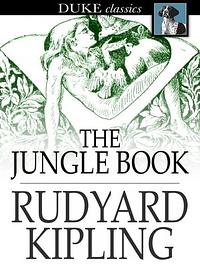You need to sign in or sign up before continuing.
Take a photo of a barcode or cover
emotional
funny
inspiring
fast-paced
adventurous
slow-paced
A short commentary on the book. This book clearly influences western culture and literature immensely. More than just Disney's version (in which the reversed the personalities of Baloo, Baghera, and Kaa), which I love dearly. In things I've read in just the last six months or so, Neil Gaiman and J.R.R. Tolkien both have been heavily influenced. I would strongly recommend this book to anybody even if you have read it before.
A short rant on the author: So, I've been on a bit of a Victorian kick lately, and this is the best one yet. Why isn't he on required reading lists in school? He is clearly a product of his age, and some opinions he holds are quaint now, but he was ahead of his time then, a powerful writer and poet, and I can't wait until [b:Kim|10441|The Memory Keeper's Daughter|Kim Edwards|http://ecx.images-amazon.com/images/I/41zZh661A0L._SL75_.jpg|2868431] rises to the top of my to read stack. I hadn't read him much before just due to my partial association of him in my head with modern jingoist literature (they do reference him a lot), and that was a grave error
A short rant on the author: So, I've been on a bit of a Victorian kick lately, and this is the best one yet. Why isn't he on required reading lists in school? He is clearly a product of his age, and some opinions he holds are quaint now, but he was ahead of his time then, a powerful writer and poet, and I can't wait until [b:Kim|10441|The Memory Keeper's Daughter|Kim Edwards|http://ecx.images-amazon.com/images/I/41zZh661A0L._SL75_.jpg|2868431] rises to the top of my to read stack. I hadn't read him much before just due to my partial association of him in my head with modern jingoist literature (they do reference him a lot), and that was a grave error
Estas dos cosas luchan dentro de mí como serpientes en la primavera. Lloran mis ojos lágrimas, y al mismo tiempo río.
¿Por qué? Soy dos Mouglis, pero tengo a mis pies la piel de Shir Jan. Toda la selva sabe que he dado muerte al tigre.
¡Mirad, lobos, mirad! ¡Ay! Mi corazón está lleno de cosas que no entiendo , de cosas que me pesan y me llenan de pena.
Los libros de la jungla, (The Jungle Book / The Second Jungle Book) 1894-95
Rudyard Kipling
@albaeditorial
Traducción de Catalina Martínez Muñoz
Si hablamos de El libro de la selva de Rudyard Kipling, Mougli, el niño-lobo, el oso Balú, la pantera Baguira y la pitón Ka, nos vienen enseguida a la cabeza.
Pero en Los libros de la Selva hay mucho más que la historia de como Mowgli se convierte en el amo de la selva de Sioni, en la India.
Encontramos historias no protagonizadas por Mowgli e incluso ambientadas fuera de la India, en lugares tan lejanos como el Ártico .
Tienen en común hablarnos de abandono y pertenencia, de libertad y de supervivencia y ese infantil anhelo de hermanarse con nuestros compañeros animales.... A pesar de que finalmente "el hombre vuelve al hombre".
He disfrutado muchísimo de estos relatos de Kipling y debo agradecer al @clubclasicosjuveniles la estupenda organización de una LC con varios conductores que han hecho de este viaje una aventura increíble. ¡Mil gracias!!
¿Por qué? Soy dos Mouglis, pero tengo a mis pies la piel de Shir Jan. Toda la selva sabe que he dado muerte al tigre.
¡Mirad, lobos, mirad! ¡Ay! Mi corazón está lleno de cosas que no entiendo , de cosas que me pesan y me llenan de pena.
Los libros de la jungla, (The Jungle Book / The Second Jungle Book) 1894-95
Rudyard Kipling
@albaeditorial
Traducción de Catalina Martínez Muñoz
Si hablamos de El libro de la selva de Rudyard Kipling, Mougli, el niño-lobo, el oso Balú, la pantera Baguira y la pitón Ka, nos vienen enseguida a la cabeza.
Pero en Los libros de la Selva hay mucho más que la historia de como Mowgli se convierte en el amo de la selva de Sioni, en la India.
Encontramos historias no protagonizadas por Mowgli e incluso ambientadas fuera de la India, en lugares tan lejanos como el Ártico .
Tienen en común hablarnos de abandono y pertenencia, de libertad y de supervivencia y ese infantil anhelo de hermanarse con nuestros compañeros animales.... A pesar de que finalmente "el hombre vuelve al hombre".
He disfrutado muchísimo de estos relatos de Kipling y debo agradecer al @clubclasicosjuveniles la estupenda organización de una LC con varios conductores que han hecho de este viaje una aventura increíble. ¡Mil gracias!!
Quotes:
…Baloo, the Teacher of the Law, taught him the Wood and Water Laws: how to tell a rotten branch from a sound one; how to speak politely to the wild bees when he came upon a hive of them fifty feet above the ground; what to say to Mang the Bat when he disturbed him in the branches at midday: and how to warn the water-snakes in the pools before he splashed down among them.
——————
…a full meal makes a slow mongoose…
…Baloo, the Teacher of the Law, taught him the Wood and Water Laws: how to tell a rotten branch from a sound one; how to speak politely to the wild bees when he came upon a hive of them fifty feet above the ground; what to say to Mang the Bat when he disturbed him in the branches at midday: and how to warn the water-snakes in the pools before he splashed down among them.
——————
…a full meal makes a slow mongoose…
emotional
inspiring
reflective
medium-paced
Plot or Character Driven:
A mix
Strong character development:
No
Loveable characters:
Yes
Diverse cast of characters:
Yes
Flaws of characters a main focus:
No
adventurous
slow-paced
Plot or Character Driven:
Plot
Strong character development:
No
Loveable characters:
Yes
Diverse cast of characters:
Yes
Flaws of characters a main focus:
No
The writing itself was about as average as I would expect. The blatant racism, however - much worse.
But seriously, they didn't even bother giving names to anyone who was "other" and just categorized. Because clearly all people of the same nationality are the same but white people of the British Empire are all diverse and respectable. Very clear vibes here.
I will say that the Mowgli stories were okay. I was surprised at how little they made up part of the book, as it's the only thing the movie focus on, with not even any mention of the other stories. And since I was watching the movie concurrently with the book, I'll say it: the movie was better, both in terms of the story and characters, and the less blatantly obvious racism. And Rikki-Tikki-Tavi wasn't terrible. Pretty bland, but not bad.
But it was everything after the Mowgli stories that went downhill quickly. First of all, "The White Seal?" You can't tell me that's not a blatant metaphor for the "manifest destiny" that was the ideal of the time. You can't tell me that it's not significant that the only WHITE seal (the hero) seeks out the help of the other animals and then pushes them out of their lands to make space for his own people (especially the "sea cows" - if that's a reference to manatees, the Columbus symbolism is STRONG here).
Then there was "Her Majesty's Servants," which touts the magnificence of the British Empire through the horses and donkeys "educating" and mocking the camel and the elephant in British display of power. On the surface, it looks like it's a progressive dialogue, but it's touting the totality and magnificence of the British empire and belittling the natives "peoples" (in this case, animals). It's pretty uncomfortable when you see the deeper implications.
I wanted to read this because I needed it for a challenge and we happened to be watching it with the kids at work at the same time. I'd ended up looking up a lot of the racist implications in the Disney movie and going down a rabbit hole with what I found there, especially about the King Louie scene. I can definitely see how the specific racism used by Disney in the 1960s derives from the racism Kipling used against the Indians and native peoples of the time.
I guess I'm glad I read it, because now I can say that I did, and I don't have to wonder about it anymore. The Disney movie was one I liked a lot growing up, although I never saw the live action / CGI one (and I don't feel any particular need to). I think it's still good to read these older texts, especially for educators, and to help kids understand the ideologies behind everything. I could see this still being applicable in schools as literature when talking about bias. It isn't one that I wouldn't recommend kids read on their own without help processing them, but I think it can still be applicable as middle grade literature if approached in the right way.
But seriously, they didn't even bother giving names to anyone who was "other" and just categorized. Because clearly all people of the same nationality are the same but white people of the British Empire are all diverse and respectable. Very clear vibes here.
I will say that the Mowgli stories were okay. I was surprised at how little they made up part of the book, as it's the only thing the movie focus on, with not even any mention of the other stories. And since I was watching the movie concurrently with the book, I'll say it: the movie was better, both in terms of the story and characters, and the less blatantly obvious racism. And Rikki-Tikki-Tavi wasn't terrible. Pretty bland, but not bad.
But it was everything after the Mowgli stories that went downhill quickly. First of all, "The White Seal?" You can't tell me that's not a blatant metaphor for the "manifest destiny" that was the ideal of the time. You can't tell me that it's not significant that the only WHITE seal (the hero) seeks out the help of the other animals and then pushes them out of their lands to make space for his own people (especially the "sea cows" - if that's a reference to manatees, the Columbus symbolism is STRONG here).
Then there was "Her Majesty's Servants," which touts the magnificence of the British Empire through the horses and donkeys "educating" and mocking the camel and the elephant in British display of power. On the surface, it looks like it's a progressive dialogue, but it's touting the totality and magnificence of the British empire and belittling the natives "peoples" (in this case, animals). It's pretty uncomfortable when you see the deeper implications.
I wanted to read this because I needed it for a challenge and we happened to be watching it with the kids at work at the same time. I'd ended up looking up a lot of the racist implications in the Disney movie and going down a rabbit hole with what I found there, especially about the King Louie scene. I can definitely see how the specific racism used by Disney in the 1960s derives from the racism Kipling used against the Indians and native peoples of the time.
I guess I'm glad I read it, because now I can say that I did, and I don't have to wonder about it anymore. The Disney movie was one I liked a lot growing up, although I never saw the live action / CGI one (and I don't feel any particular need to). I think it's still good to read these older texts, especially for educators, and to help kids understand the ideologies behind everything. I could see this still being applicable in schools as literature when talking about bias. It isn't one that I wouldn't recommend kids read on their own without help processing them, but I think it can still be applicable as middle grade literature if approached in the right way.
adventurous
medium-paced
Plot or Character Driven:
Character
Strong character development:
Yes
Loveable characters:
Yes
Diverse cast of characters:
Yes
Flaws of characters a main focus:
Yes
Solid, would've enjoyed more if it wasn't homework and on Sparx read getting asked questions about it ever 10 minutes






